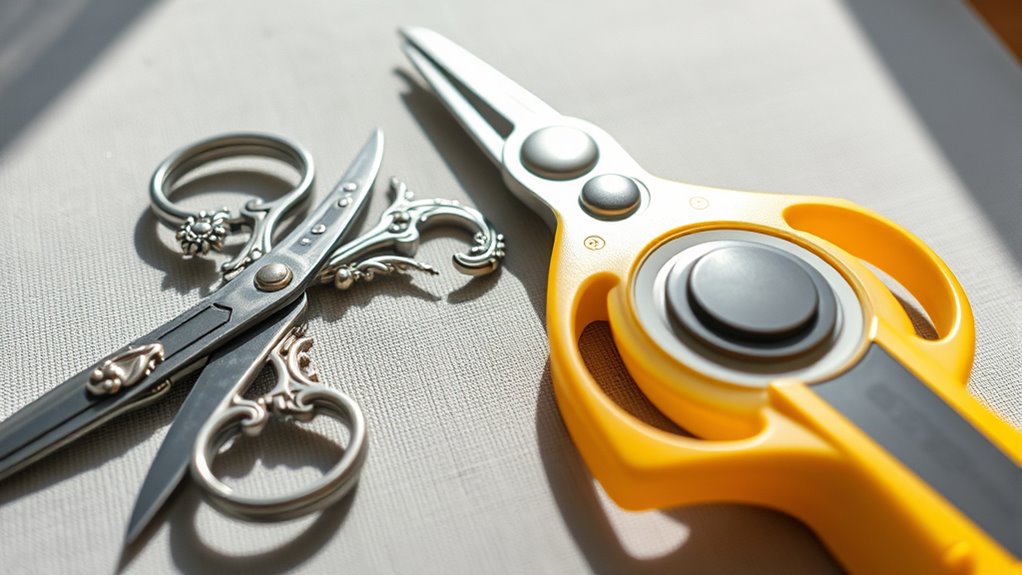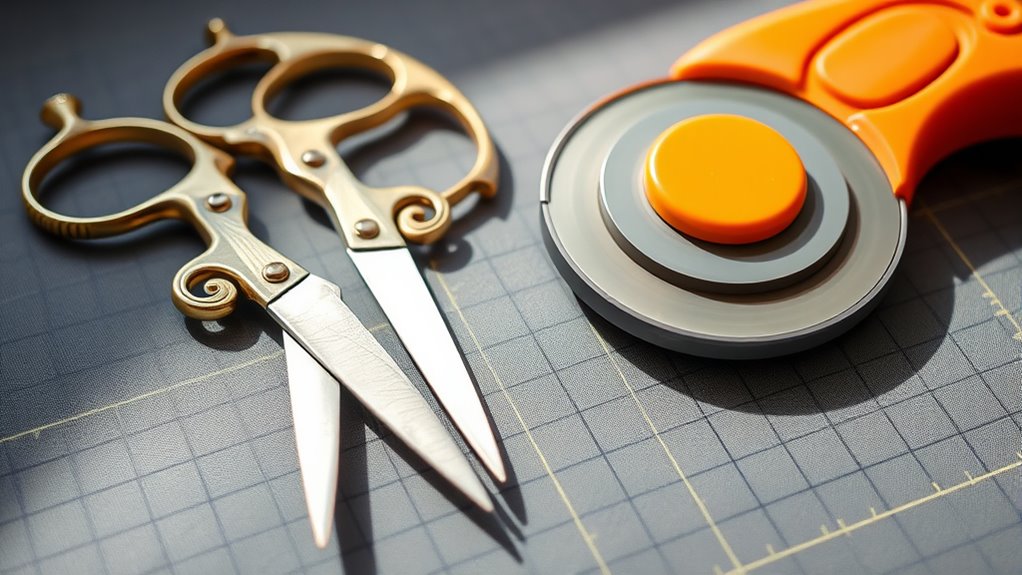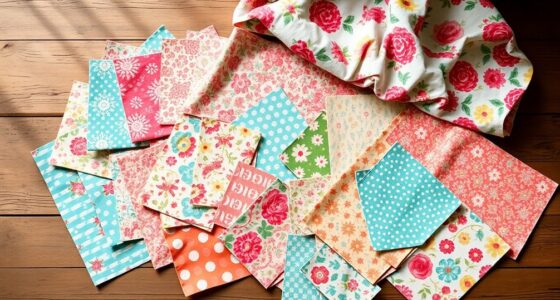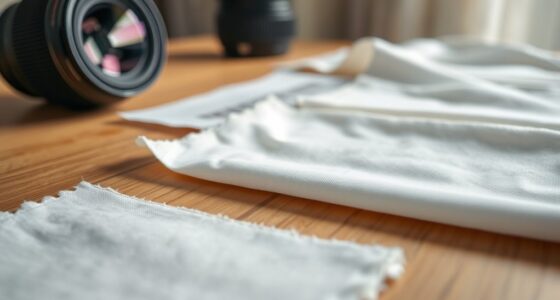When choosing between fabric scissors and rotary cutters, consider your project’s needs. Use scissors for detailed, precise cuts on small or intricate fabrics, giving you control and clean edges. Opt for rotary cutters when working on large, straight, or layered pieces, as they cut quickly and efficiently. Understanding each tool’s strengths helps improve your sewing or quilting results. If you want to master when and how to use them effectively, keep exploring the details.
Key Takeaways
- Use fabric scissors for detailed, precise cuts and projects requiring fine control and clean edges.
- Opt for rotary cutters for quick, straight cuts on large or multiple fabric layers.
- Choose scissors for intricate tasks like applique or small-scale sewing projects.
- Use rotary cutters to efficiently cut long strips or repetitive shapes in bulk.
- Keep both tools available to handle different project needs for optimal sewing and quilting results.

When choosing between fabric scissors and rotary cutters, understanding their differences can help you make the best tool for your project. Both tools serve the purpose of cutting fabric, but they excel in different areas thanks to their design and functionality. One key factor to consider is blade precision. Fabric scissors typically feature sharp, straight blades that allow for detailed, accurate cuts, especially when you need clean edges or intricate shapes. The precision of the blades ensures you don’t accidentally fray the fabric or create uneven edges, which is essential for projects that demand high accuracy, like applique or detailed quilting. On the other hand, rotary cutters have a circular blade that rolls smoothly across fabric, offering consistent cuts and helping you achieve straight, even lines with less effort. While they may not provide the same level of fine detail as scissors, rotary cutters excel in maintaining blade precision over longer cuts, especially when paired with a straight edge or cutting mat.
Cutting speed is another critical aspect that influences your choice. Fabric scissors require a steady, controlled motion, which can take more time, especially if you’re working on large pieces or multiple layers. They’re ideal when you need precision over speed or are working on small, intricate projects. Rotary cutters, however, are designed for rapid cutting, making them perfect for larger projects or when you need to cut multiple layers quickly. The rolling blade glides through fabric with minimal resistance, greatly reducing cutting time. This efficiency is especially beneficial in quilting or sewing projects where uniform strips or shapes are needed repeatedly. Additionally, rotary cutters can help maintain evenness across cuts, which is harder to achieve with scissors during long stretches.
Furthermore, the home theatre projectors often utilize precise calibration and consistent performance, just like rotary cutters excel in maintaining blade consistency over long cuts. Ultimately, your choice depends on the specific demands of your project. If you’re working on detailed, small-scale items requiring finesse and crisp edges, fabric scissors are your best bet. They give you the control needed for precise blade placement and intricate designs. If speed and consistency are your priorities, especially on larger fabrics or multiple layers, a rotary cutter will serve you better. It’s also worth noting that many crafters keep both tools handy, switching between them as the project requires. By understanding how blade precision and cutting speed differ between fabric scissors and rotary cutters, you can select the right tool to make your sewing or quilting experience smoother, faster, and more accurate.
Frequently Asked Questions
Can Fabric Scissors Cut Through Multiple Fabric Layers Effectively?
Yes, fabric scissors can cut through multiple layers of fabric effectively, but your cutting efficiency depends on the scissors’ sharpness and quality. For thick or layered fabric, high-quality, sharp scissors make the job easier and cleaner. Make certain you use smooth, even strokes to prevent jagged edges. If you’re working with many layers regularly, consider investing in specialized scissors designed for layered cutting to improve precision and reduce fatigue.
Are Rotary Cutters Safe for Children or Beginners?
Did you know that rotary cutters cause over 20,000 injuries annually? They’re not ideal for children or beginners due to their sharp blades and potential safety risks. While they offer precision, child safety and beginner tools should prioritize ease of use and safety features. For kids or newcomers, fabric scissors are safer and more manageable, helping them develop skills without risking injury. Always supervise and choose age-appropriate, safe tools.
How Do Fabric Scissors Impact Fabric Quality Over Time?
You might wonder how fabric scissors impact fabric quality over time. When you use sharp blades consistently, fabric remains smooth and undamaged. Dull blades can cause uneven cuts, fraying, or tearing, reducing material durability. To keep your fabric in top condition, regularly sharpen or replace your scissors. Properly maintained scissors ensure clean cuts, preserving fabric quality and extending its lifespan, so your projects stay professional and durable.
What Maintenance Is Required for Rotary Cutters?
Imagine you’re in a time before safety goggles—rotary cutters need your attention to stay safe. Regular blade sharpening is essential; dull blades cause inaccurate cuts and pose safety risks. Always follow safety precautions, like using a cutting mat and handling blades carefully. Substitute blades when they become dull, and clean the cutter after use. Proper maintenance ensures your rotary cutter stays sharp, safe, and effective for all your projects.
Can Both Tools Be Used on Delicate or Stretchy Fabrics?
You can use both fabric scissors and rotary cutters on delicate or stretchy fabrics, but exercise caution for fabric safety. Fabric scissors provide precise cuts without stretching the material, making them ideal for delicate textiles. Rotary cutters offer tool versatility and can quickly cut through multiple layers, but they may cause stretching or fraying if not used carefully. Always test on scrap fabric first to guarantee a clean, safe cut.
Conclusion
So, when it comes to cutting fabric, choosing between scissors and rotary cutters can feel like deciding between a superhero and a sidekick. Use scissors for quick, small cuts—like a ninja in a hurry—and turn to rotary cutters when you need laser-precision on massive projects. Mastering this duo will make you unstoppable, transforming you into a fabric-cutting legend. Get it right, and you’ll cut fabric faster than a lightning bolt—no more snags or mistakes!









